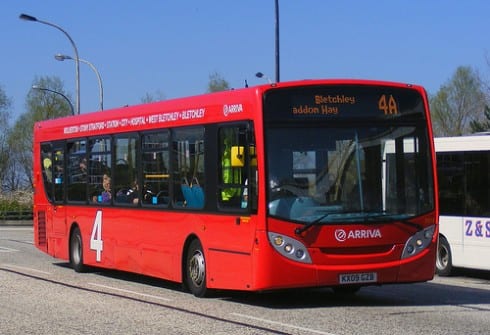The power management and automotive company Eaton has just introduced its new HyperCharger wireless charging system for electric buses in Europe, demonstrating once again that electric vehicle technology provides new opportunities that liquid fuels have a hard time beating. The HyperCharger is designed specifically to enable on-route charging for electric buses, which means that routes no longer need to be tethered to centralized fueling stations and there is no need to travel off-route for fuel.
In contrast to liquid fuel stations, which need regular deliveries of fuel by truck, charging stations require no such attention once they are installed. Since the Eaton HyperCharger is taking aim at the “world’s largest fleets of electric buses,” the cumulative savings adds up.
The Eaton On-Route HyperCharger
Eaton already has an EV fast charging system on the market called the DC Quick Charger, which has a 50kW (kilowatt) output through five 10kW power drawers. It provides an 80 percent charge in about half an hour.
That’s pretty good for most consumer EVs but obviously not so great for on-route electric bus charging, unless you time it with a rest stop. The new HyperCharger easily beats that with an output scalable from 200 kW to one mW (megawatt). The company’s press materials don’t list a charging time but on a demonstration basis, an average of eight on-route passes along the HyperChargers provided all of the electricity needed for the average 240-mile-per-day trip.
The Wireless Bus Route Of The Future
Also no word in the press materials on the potential for wireless charging (cagey, those Eaton folks!), but as an off-board system the HyperCharger concept is not too far removed from that, so let’s take a look at the future of EV charging. We’re already seeing wireless EV charging from companies like Evatran, Hevo Power, and Qualcomm (which recently hooked up with Britain’s Drayson Racing, no less), and just last year the US Department of Energy announced $4 million in funding for next-generation wireless systems. Most of this activity is focused on consumer vehicles but on-route wireless electric bus charging is also steadily advancing. One of the projects we’re following is the wireless electric bus system developed by Utah State University. When it was unveiled in November 2012 the “Aggie Bus,” as they call it, was the first and only bus of its kind developed exclusively by a North American research institute, and according to Utah State it was also the first of its kind in the world to achieve key performance standards for a wirelessly charged vehicle. The pad-based wireless system involves no moving parts, which saves wear and tear on the equipment as well as sparing drivers from any potential safety hazards of having to get off the bus to plug in. The Utah Transit Authority has also committed itself to launching a full scale demonstration-scale test of the system, using a 40-foot transit bus on a public route that runs through the University of Utah in Salt Lake City. Not for nothing, but pretty soon you won’t even have to park over a pad to charge up. The Energy Department is already eyeballing funds for developing charging-on-the-go systems embedded in roadways.
More About Eaton
This is a good opportunity to catch up on some of the other Eaton innovations we’ve been following, so here goes. In 2010, Eaton teamed up with Peterbilt to launch a new hybrid garbage truck that cut fuel consumption by 30 percent, using Eaton’s new Hydraulic Launch Assist technology. The system, designed for large vehicles that make frequent stops, stores the waste kinetic energy from braking in the form of pressurized hydraulic fluid. When the vehicle accelerates, the stored energy gives it an extra push. Aside from the potential for saving thousands of dollars annually on fuel, the system also saves a considerable amount of wear and tear on the vehicle. Last year, Eaton announced that it was partnering in a project funded by the Energy Department’s cutting edge ARPA-E division, with the goal of reducing the size of its battery for hybrid systems by 50 percent and increasing the charge rate (in other words, decreasing the charge time), while improving the overall performance of the vehicle.
This article was originally published on CleanTechnica. Reproduced with permission
Read more at http://cleantechnica.com/2013/12/10/eaton-introduces-wireless-charging-in-europe/#esM10iGLVCqv4EjS.99








